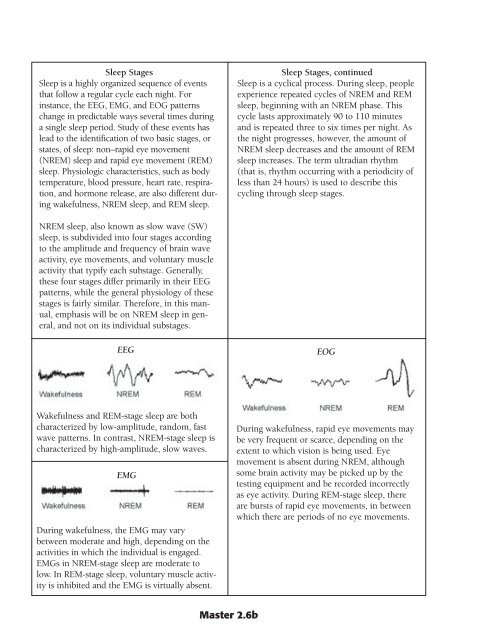Biological - NIH Office of Science Education - National Institutes of ...
Biological - NIH Office of Science Education - National Institutes of ...
Biological - NIH Office of Science Education - National Institutes of ...
Create successful ePaper yourself
Turn your PDF publications into a flip-book with our unique Google optimized e-Paper software.
Sleep Stages<br />
Sleep is a highly organized sequence <strong>of</strong> events<br />
that follow a regular cycle each night. For<br />
instance, the EEG, EMG, and EOG patterns<br />
change in predictable ways several times during<br />
a single sleep period. Study <strong>of</strong> these events has<br />
lead to the identification <strong>of</strong> two basic stages, or<br />
states, <strong>of</strong> sleep: non–rapid eye movement<br />
(NREM) sleep and rapid eye movement (REM)<br />
sleep. Physiologic characteristics, such as body<br />
temperature, blood pressure, heart rate, respiration,<br />
and hormone release, are also different during<br />
wakefulness, NREM sleep, and REM sleep.<br />
Sleep Stages, continued<br />
Sleep is a cyclical process. During sleep, people<br />
experience repeated cycles <strong>of</strong> NREM and REM<br />
sleep, beginning with an NREM phase. This<br />
cycle lasts approximately 90 to 110 minutes<br />
and is repeated three to six times per night. As<br />
the night progresses, however, the amount <strong>of</strong><br />
NREM sleep decreases and the amount <strong>of</strong> REM<br />
sleep increases. The term ultradian rhythm<br />
(that is, rhythm occurring with a periodicity <strong>of</strong><br />
less than 24 hours) is used to describe this<br />
cycling through sleep stages.<br />
NREM sleep, also known as slow wave (SW)<br />
sleep, is subdivided into four stages according<br />
to the amplitude and frequency <strong>of</strong> brain wave<br />
activity, eye movements, and voluntary muscle<br />
activity that typify each substage. Generally,<br />
these four stages differ primarily in their EEG<br />
patterns, while the general physiology <strong>of</strong> these<br />
stages is fairly similar. Therefore, in this manual,<br />
emphasis will be on NREM sleep in general,<br />
and not on its individual substages.<br />
EEG<br />
EOG<br />
Wakefulness and REM-stage sleep are both<br />
characterized by low-amplitude, random, fast<br />
wave patterns. In contrast, NREM-stage sleep is<br />
characterized by high-amplitude, slow waves.<br />
EMG<br />
During wakefulness, the EMG may vary<br />
between moderate and high, depending on the<br />
activities in which the individual is engaged.<br />
EMGs in NREM-stage sleep are moderate to<br />
low. In REM-stage sleep, voluntary muscle activity<br />
is inhibited and the EMG is virtually absent.<br />
During wakefulness, rapid eye movements may<br />
be very frequent or scarce, depending on the<br />
extent to which vision is being used. Eye<br />
movement is absent during NREM, although<br />
some brain activity may be picked up by the<br />
testing equipment and be recorded incorrectly<br />
as eye activity. During REM-stage sleep, there<br />
are bursts <strong>of</strong> rapid eye movements, in between<br />
which there are periods <strong>of</strong> no eye movements.<br />
Master 2.6b

















